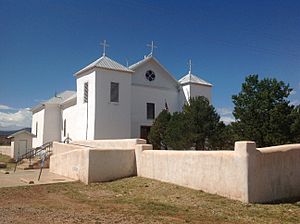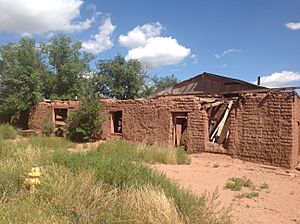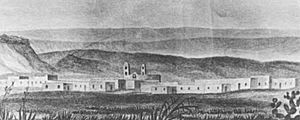San Miguel del Vado, New Mexico facts for kids
Quick facts for kids
San Miguel del Vado, New Mexico
|
|
|---|---|
|
unincorporated community
|
|

The church in San Miguel del Vado
|
|
| Country | United States |
| State | New Mexico |
| County | San Miguel |
| Elevation | 6,024 ft (1,836 m) |
| Time zone | UTC-7 (Mountain (MST)) |
| • Summer (DST) | UTC-6 (MDT) |
San Miguel del Vado (also spelled Bado) is a small community in San Miguel County, New Mexico, in the United States. It's a place that isn't officially governed by its own local city or town government.
Contents
About San Miguel del Vado
This community is located about 2 kilometers (1.2 miles) south of Interstate Highway 25. It's also near Ribera, which is a place the government uses for counting people.
San Miguel del Vado was very important in the 1800s. It was a key community for people of Hispanic heritage, especially a group called genizaros. The famous Santa Fe Trail used to pass right through San Miguel. The community sits on the west bank of the Pecos River, along New Mexico Highway 3.
In 1972, San Miguel del Vado was added to the National Register of Historic Places. This means it's recognized as a special place with important history. The name "San Miguel del Vado" means "Saint Michael of the Ford". A "ford" is a shallow place in a river where you can cross.
Early History of San Miguel del Vado
San Miguel del Vado is about 35 kilometers (22 miles) downstream from the Pecos Pueblo. The Pecos Pueblo was the easternmost village of the Pueblo Indians back in the 1500s. That's when Spanish explorers first came to the area.
Spanish settlements in New Mexico mostly started near the Rio Grande river around 1598. The Spanish had trouble expanding because they often fought with Native American groups like the Comanche, Apache, Navajo, and Ute Indians.
In the 1780s, the Spanish made peace with the Comanche. After that, the Comanche helped the Spanish fight the Apache. This made the area safer, allowing the Spanish to move eastward towards the Great Plains.
Founding the Community
In 1794, 52 families asked the Spanish government for permission to settle in the San Miguel del Vado area. Lorenzo Marquez led these families. Thirteen of these families were described as "Indians," likely from the Pecos Pueblo, which was getting smaller. Most of the other families were genizaros. Genizaros were Native Americans who had adopted Spanish culture and Christianity. Many were of Comanche or other Native American backgrounds.
These families had 25 firearms. They promised that every man would have a weapon. They also said they would build a strong, fortified plaza (a central square) to protect themselves. The land they were given was called the San Miguel del Vado Land Grant. It was a huge area, about 315,000 acres (127,000 hectares).
Growth and Life in the Village
In 1803, the Spanish government divided the farming land of the grant. Each of the 58 families living in San Miguel del Vado got their own plot. But pastures and watering places were shared by everyone. More land was given to 45 men and two women at San Jose del Vado. This village was about 6 kilometers (3.7 miles) upstream from San Miguel.
In 1805, a Roman Catholic church was built in San Miguel. By 1812, about 230 families lived in San Miguel, San Jose del Vado, and other nearby places along the Pecos River. San Miguel was the main political and military center for the Spanish settlements in the Pecos River valley, east of the Rocky Mountains.
A count in 1827 showed 2,893 people living in San Miguel and other communities in the Pecos River valley. Most men worked as farmers or day laborers. Some were craftsmen, merchants, or even a school teacher. The village of San Miguel itself probably had about 400 to 500 people.
Farmers grew crops like corn, beans, wheat, chiles, tobacco, peaches, and apricots on the irrigated land near the Pecos River. Sheep and goats were the most important animals raised. They grazed mostly on the shared lands of the grant. Many people in San Miguel also made a living by trading with the Comanches and other Plains Indians. This trade was sometimes against the rules.
The Spanish government didn't always trust the people of San Miguel completely. In 1805, some men were arrested for breaking rules about trading with the Plains Indians. However, by 1808, the Spanish were worried about Americans moving onto the Great Plains. They also feared new wars with the Comanche. So, they organized a group of genízaros from San Miguel to patrol the plains. Their job was to gather information about both the Plains Indians and the Americans. The famous comancheros (traders) and ciboleros (bison hunters) of the 1800s were mostly men from these Pecos River Valley settlements.
The American Era

San Miguel del Vado became even more important during the time of the Santa Fe Trail (1821–1880). The town was located right on the trail, near a place where wagons could cross the Pecos River.
In 1821, William Becknell led the first trading trip from Independence, Missouri, to Santa Fe, New Mexico. He stopped in San Miguel before going on to Santa Fe. After that, a lot of trade happened on the Santa Fe Trail between the U.S. and Mexico.
People in San Miguel sold food and supplies to American traders. They also worked as guides and wagon drivers for the Americans. They collected fees and taxes on American goods, mostly fabrics. An American named William Rowland married a local woman and opened a store in San Miguel in 1838.
In 1841, some Texans who were captured during the Texan Santa Fe Expedition were held as prisoners in San Miguel for a short time. On August 16, 1846, during the Mexican–American War, U.S. General Stephen W. Kearney and his soldiers took control of San Miguel. From then on, the village was under United States rule.
Decline of San Miguel del Vado
San Miguel del Vado started to lose its importance after 1860. This was when the government of San Miguel County moved its main offices to Las Vegas. Then, in 1881, the railroad was built. It didn't go through San Miguel but instead went through Ribera, bypassing the village.
In 1897, the Supreme Court of the United States made a decision that greatly reduced the size of the San Miguel del Vado Land Grant. It went from 315,000 acres (127,000 hectares) down to only 5,000 acres (2,000 hectares). This meant the people of San Miguel and other communities lost their shared ownership of the "pasture, timber and other resources" within the grant area. This change had a big impact on the community.



